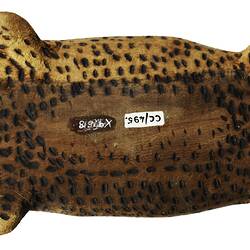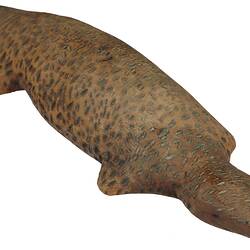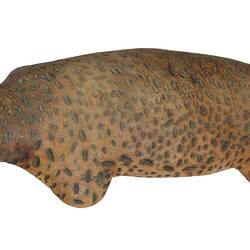Summary
The Stumpy-tailed Lungkata (blue-tongued lizard) has a very large head, short blunt tail and large rough scales. It has a broad blue tongue, which it bares as a warning to potential predators. The Tjukurrpa (Creation Story) about Lungkata teaches the Pitjantjatjara about fire management of the land.
One day while camping at Uluru, Lungkata came upon a wounded Kalaya (Emu), still dragging a spear from another hunt. He knew the wounded bird belonged to other hunters and it would be wrong for someone else to kill it and eat it. Yet he began cutting it up and cooking it anyway.
When the two Panpanpalala (crested bellbird) hunters who had wounded the Kalaya came and asked Lungkata if he had seen their bird, he lied, saying he had seen nothing. Disappointed, they walked off, but when they located the tracks of the Kalaya they knew he had lied.
Meanwhile, Lungkata gathered up his stolen meal and raced to his permanent camp, dropping pieces of meat behind him. Following his trail, the two Panpanpalala hunters caught up with Lungkata and made a huge bonfire under the slow, fat lizard as he struggled upwards to his camp. The greedy and dishonest thief choked on the smoke and was burnt by the flames. Lungkata reminds us what happens to the greedy and dishonest
Local Name
Lungkata
Physical Description
Stumpy tailed lizard carved from Mulga wood. Body is rounded and stylized with a short tail, short legs and slightly pointed head. Decorated with burnt marks running horizontally across the body at regular intervals - except for the belly which is plain.
Significance
Aboriginal people of the central and western desert areas of Australia refer to themselves by the names of their dialects: the Pitjantjatjara, the Yankunytjatjara, the Ngaanyatjarra and the Ngaatjatjarra people. Anangu literally means person or human being in Pitjantjatjara and Yankunytjatjara. Anangu has come to be used as a collective noun in this area, just as people might be referred to as Koori or Murri in eastern Australia.
Contemporary carvings by Anangu (Central and Western Desert Aboriginal people) are known as punu, hand carved and decorated with patterns burnt into the wood. The animals all have their associations with the Tjukurpa, the stories of the Creation Ancestors and the activities which shaped the land, the people and the Law.
Regrettably the name of the Pitjantjatjara person who made this lungkata punu (lizard carving) was not recorded when it came into the Museum collection. It is known that the artist from the Mulga Park area of the Central Desert, which identifies as Anangu (people from the Central and Western Deserts) and speaks a Pitjantjatjara dialect.
Today, the Anangu live in small communities and outstations across over 103,000 square kilometres of their traditional lands. In the summer, family groups move north to attend ceremonies.
More Information
-
Object/Medium
Animal figure
-
Maker
-
Cultural Groups
-
Locality
-
Date Produced
-
Collector
-
Date Collected
-
Object Measurements
330 mm (Length), 105 mm (Width), 60 mm (Height)
-
Classification
-
Date Made
-
Maker
-
Clan/Language Group
-
Place Made
-
Indigenous Region
-
Keywords
-
Collection Names
-
Type of item
-
Discipline
-
Category
-
Collecting Areas






